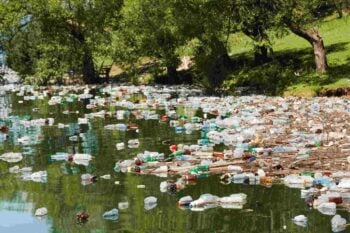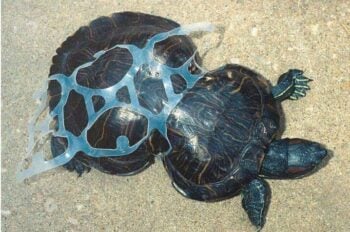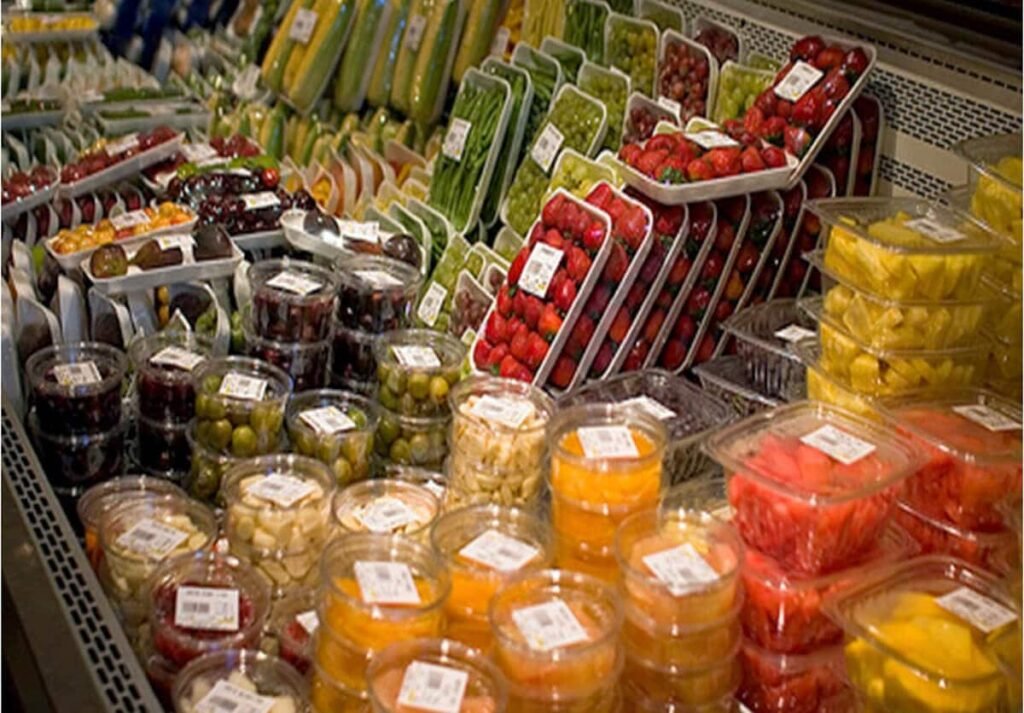It is extremely potential to get a lot of the plastic out of your life—particularly the disposable and single-use plastic. (Although sturdy items like computer systems and automotive elements would be the exception). Begin with the low hanging fruit first, like shopping for your eggs in cardboard as a substitute of polystyrene. Then contemplate taking over only one or two of the larger adjustments a month.
Listed below are some options for decreasing each your use of plastic and your publicity to its toxins:
Cut back the Plastic in Your Life
All of us have to lower our reliance on plastic to reduce its affect on our well being and the atmosphere as a lot as potential. Listed below are some nice methods to get began.
Out and About
- When buying, use reusable produce bags to carry your produce, and reusable grocery luggage to hold all of your gadgets residence. Right here’s a straightforward option to always remember them. It’s also possible to use reusable cotton sacks for bulk gadgets like espresso, rice and nuts.
- Use reusable baggies as a substitute of disposable plastic baggies for lunches and snacks.
- Use reusable glass or stainless steel water bottles to hold water with you.
- Deliver your personal containers to the restaurant for each carryout and leftovers. I take advantage of these containers, and so long as I hand them over on the identical time I order my takeout, nobody has turned me down but.)
- Deliver your personal stainless steel coffee thermos to the espresso store or workplace with you. Most espresso outlets don’t have any drawback placing your latté in a reusable thermos.
- Ask in your newspaper and dry cleansing with out plastic wrap.
- Don’t take the receipt on the register, or have the cashier drop it into the bag, then solely deal with it utilizing gloves. These slick, thermal-paper money register receipts are a major source of BPA contamination by way of your pores and skin.
Pantry and Fridge
- Since plastic is discovered extensively in processed meals packaging (this contains canned meals and drinks, which have a plastic lining), the largest factor you are able to do to scale back plastic toxins in your life is to shift your eating regimen to incorporate primarily contemporary, entire, unpackaged meals from the grocery, farmer’s market or meals co-op. Shopping for in bulk or joining a buying club could make this very inexpensive.
- Get your contemporary eggs in cardboard cartons, not polystyrene. Get your contemporary meat and cheese wrapped in waxed butcher paper, as a substitute of plastic and foam.
- Get your contemporary milk in bottles, not plastic-coated cartons or jugs. Many shops and farmers encourage you to return the empty bottle in alternate for financial savings in your subsequent full one.
- Use old style, waxed butcher paper if you purchase and retailer meats and cheeses. Use reusable freezer bags to carry freezer gadgets that may’t go into glass or butcher paper.
- Keep away from canned meals and drinks, together with canned child formulation. You will get many canned meals gadgets, like crushed tomatoes or broth, in glass jars or tetrapaks as a substitute. Should you can’t discover different packaging, just a few corporations are providing their merchandise in BPA-free cans, and the quantity continues to develop on account of public demand. Here’s a list.
Kitchen
- Get a good water filter for your tap to switch bottled water. Or, if nothing else, purchase bottled water solely in reusable 5-gallon polycarbonate containers, and hold them in a cool, darkish place. (Here’s how to find one.)
- Skip the straw together with your drink, or use a washable, reusable straw as a substitute.
- Retailer, reheat or freeze your leftovers in glass containers as a substitute of in plastic “tupperware” or plastic wrap. (These are the containers we use, and whereas not 100% plastic-free, we love them.)
- Keep away from disposable plastic or polystyrene dishes and utensils. As an alternative, go to the thrift retailer and get a stack of tremendous low-cost mismatched ceramic dishes and stainless-steel cutlery that you just use just for events, picnics and the like.
- Change your plastic kitchenware with gadgets constituted of stainless-steel, glass, ceramic, and even silicone as a substitute.
- Make your own cleaners from non-toxic substances, and retailer them in glass jars and bottles. You’ll be able to even take the spray pump off of an previous spray bottle, and screw it onto a recycled glass vinegar bottle.
Private Care
- Make your personal shampoo, lotions, liquid soaps, and cosmetics and retailer them in glass, ceramic or stainless-steel containers. There are tons of DIY recipes on the web you can also make to switch all of the plastic bottles of private care potions you presently use.
- Change your toothbrush with a non-toxic one. There are eco-friendly toothbrushes on the market. Keep away from plastic toothpaste tubes (and nasty chemical substances too) by making your own toothpaste.
- All the time ask for BPA-free dental sealants and BPA-free composite fillings on the dentist workplace. In case your dentist doesn’t supply it, find one that does.
Children
- Use cloth diapers.
- As a result of kids are further inclined to the toxins in plastics, select glass bottles with actual rubber nipples, wooden or material teethers, and so forth.
- Select wooden, material, metal and paper-based toys in your kids over plastic, at any time when potential. That is particularly vital whereas your children are nonetheless younger sufficient to place issues of their mouths. See if you will get plastic toys like Legos second hand from eBay, Craigslist or different on-line retailers.
- Change your school-age baby’s plastic lunchbox with a material or stainless-steel one. There are numerous non-toxic lunchbox selections, and most are nice for adults, too!
Associated:
How Plastic Harms the Surroundings


Plastics should not solely a difficulty for our well being, but in addition for the well being of crops and animals in every single place, which is why it’s so vital to scale back the quantity of plastic in your life.
Despite nationwide recycling efforts, we presently recycle solely a measly 5 p.c of the plastics we produce. And more and more cities are shutting down their plastic recycling programs as a result of they don’t seem to be value efficient!
Roughly 50 p.c of our plastic waste goes to landfills (the place it’s going to sit for hundreds of years on account of restricted oxygen and lack of microorganisms to interrupt it down). The remaining 45 p.c finally ends up as litter within the atmosphere the place it in the end washes out to sea, damaging marine ecosystems and getting into the meals chain.
How Plastic Pollutes the Ocean


With not less than eight million metric tons of plastic getting into the world’s oceans yearly, there may be rising concern concerning the overwhelming proliferation of plastics within the atmosphere. Finally all of it accumulates into huge, Texas-sized blobs of trash floating and spiraling out and in of the world’s oceanic gyres in the present day.
A United Nations report claims there may be a mean of 46,000 items of plastic in each sq. mile of ocean. At this time, you could be aboard a ship hundreds of miles away from land, however you will note floating plastic particles in every single place.
Even in essentially the most distant reaches of the planet, you will see plastic trash. We’ve turned our oceans into the most important landfill on the earth!


The scariest half is that each one these floating plastic particles act like “sponges” for waterborne contaminants comparable to PCBs, pesticides like DDT, herbicides, and different persistent natural pollution. This makes floating plastics much more harmful than they’re on land.
Filter-feeding marine animals ingest these plastic particles and the toxins they comprise, and subsequently move them up by way of the meals chain, ultimately to people.
In reality, ninety percent of all seabird species, 22 p.c of Cetaceans (whales, dolphins and porpoises), all sea turtles, and a rising listing of fish have been found to be contaminated with plastic.
Tiny beads of plastic appear like fish eggs or different meals sources, so many sea creatures merely mistake them for meals. Loggerhead sea turtles typically confuse plastic luggage with jellyfish, their favourite meals. The results of this are disastrous, together with inside blockages, dehydration, hunger, and infrequently, demise.


Sea birds are regularly discovered strangled by the plastic rings that maintain six-packs of soda collectively, or starved by stomachs stuffed with plastic particles. Different creatures meet a painful finish by getting tousled in plastic netting.
Floating plastic particles additionally blocks the daylight that sustains plankton and algae, and since plankton and algae are the muse of the marine ecosystem, this has an infinite results up the meals chain. In some ocean waters, plastic outnumbers plankton by an element of six to 1.
There isn’t a possible or inexpensive option to clear the plastic out of the ocean. The ocean is much too violent and huge for that. The perfect factor we will do is clear up the seashores as soon as all that plastic ultimately washes up on them. (And due to pure ocean cycles, it will definitely will.)
But when we need to actually clear up our mess, the simplest, most cost-effective technique is to forestall the plastic from getting there within the first place!
How Plastic Threatens Human Well being
The heavy poisonous burden related to plastic—at each stage of its life cycle—make it clear why decreasing and phasing out the manufacturing of single-use plastics is the one approach ahead.
Based on the Heart for Worldwide Environmental Regulation, At every stage of its lifecycle, plastic poses distinct risks to human health, arising from each publicity to plastic particles themselves and related chemical substances. Individuals worldwide are uncovered at a number of phases of this lifecycle:
- “Extraction and transportation of fossil feedstocks for plastic, which releases an array of poisonous substances into the air and water, together with these with identified well being impacts like most cancers, neurotoxicity, reproductive and developmental toxicity, and impairment of the immune system;
- Refining and manufacturing of plastic resins and components, which releases carcinogenic and different extremely poisonous substances into the air, with results together with impairment of the nervous system, reproductive and developmental issues, most cancers, leukemia, and genetic impacts like low start weight;
- Client merchandise and packaging, which may result in ingestion and/or inhalation of microplastic particles and lots of of poisonous substances;
- Plastic waste administration, particularly “waste-to-energy” and different types of incineration, releases poisonous substances together with heavy metals comparable to lead and mercury, acid gases and particulate matter, which may enter air, water, and soil inflicting each direct and oblique well being dangers for staff and close by communities;
- Fragmenting and microplastics, which enter the human physique instantly and result in an array of well being impacts (together with irritation, genotoxicity, oxidative stress, apoptosis, and necrosis) which are linked to unfavourable well being outcomes starting from heart problems to most cancers and autoimmune situations;
- Cascading publicity as plastic degrades, which additional leach poisonous chemical substances concentrated in plastic into the atmosphere and human our bodies; and
- Ongoing environmental exposures as plastic contaminates and accumulates in meals chains by way of agricultural soils, terrestrial and aquatic meals chains, and the water provide, creating new alternatives for human publicity.”
Up to date July 25, 2021
